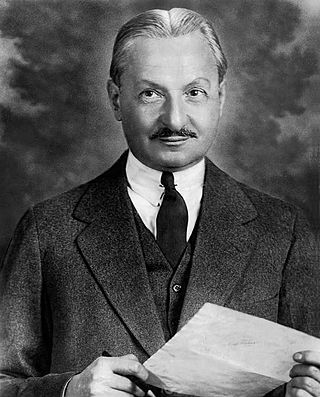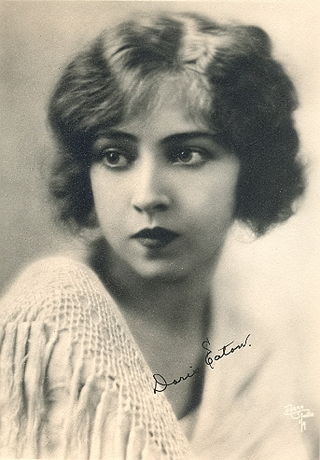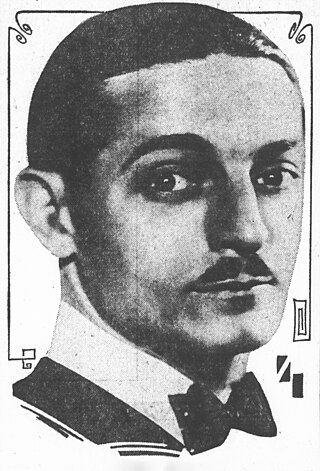Related Research Articles

Jean Schwartz was a Hungarian-born Jewish American composer and pianist. He is best known for his work writing the scores for more than 30 Broadway musicals, and for his creation of more than 1,000 popular songs with the lyricist William Jerome. Schwartz and Jerome also performed together on the vaudeville stage in the United States; sometimes in collaboration with Maude Nugent, Jerome's wife, and the Dolly Sisters. Schwartz was married to Jenny Dolly from 1913 to 1921.

The Ziegfeld Follies were a series of elaborate theatrical revue productions on Broadway in New York City from 1907 to 1931, with renewals in 1934, 1936, 1943, and 1957. They became a radio program in 1932 and 1936 as The Ziegfeld Follies of the Air.

Florenz Edward Ziegfeld Jr. was an American Broadway impresario, notable for his series of theatrical revues, the Ziegfeld Follies (1907–1931), inspired by the Folies Bergère of Paris. He also produced the musical Show Boat. He was known as the "glorifier of the American girl". Ziegfeld is a member of the American Theater Hall of Fame.

Fania Borach, known professionally as Fanny Brice or Fannie Brice, was an American comedian, illustrated song model, singer, and actress who made many stage, radio, and film appearances. She is known as the creator and star of the top-rated radio comedy series The Baby Snooks Show.

A revue is a type of multi-act popular theatrical entertainment that combines music, dance, and sketches. The revue has its roots in 19th century popular entertainment and melodrama but grew into a substantial cultural presence of its own during its golden years from 1916 to 1932. Though most famous for their visual spectacle, revues frequently satirized contemporary figures, news or literature. Similar to the related subforms of operetta and musical theatre, the revue art form brings together music, dance and sketches to create a compelling show. In contrast to these, however, revue does not have an overarching storyline. Rather, a general theme serves as the motto for a loosely related series of acts that alternate between solo performances and dance ensembles.
Nathaniel Davis Ayer was an American composer, pianist, singer and actor. He made most of his career composing and performing in England in Edwardian musical comedy and revue. He also contributed songs to Broadway shows, including some of the Ziegfeld Follies.

Harry Bache Smith was a writer, lyricist and composer. The most prolific of all American stage writers, he is said to have written over 300 librettos and more than 6000 lyrics. Some of his best-known works were librettos for the composers Victor Herbert and Reginald De Koven. He also wrote the book or lyrics for several versions of the Ziegfeld Follies.

The Black Bottom is a dance which became popular during 1920s amid the Jazz Age. It was danced solo or by couples. Originating among African Americans in the rural South, the black bottom eventually spread to mainstream American culture and became a national craze in the 1920s. The dance was most famously performed by Ann Pennington, a star of the Ziegfeld Follies, who performed it in a Broadway revue staged by Ziegfeld's rival George White in 1926.
Lew Leslie was a Jewish American writer and producer of Broadway shows. Leslie got his start in show business in vaudeville in his early twenties. Although white, he was the first major impresario to present African American artists on the Broadway stage. He had two well-known wives, torch singer Belle Baker and Ziegfeld Follies showgirl Irene Wales.

Doris Eaton Travis was an American dancer, stage and film actress, dance instructor, owner and manager, writer, and rancher, who was the last surviving Ziegfeld Girl, a troupe of acclaimed chorus girls who performed as members in the Broadway theatrical revues of the Ziegfeld Follies.

Lester M. Allen (November 17, 1891 – November 6, 1949 was an American actor, dancer, singer, comedian, and circus performer. After beginning his career as child acrobat with the Barnum and Bailey Circus, he became a performer in minstrel shows, burlesque, and vaudeville. He worked as primarily a dancer and acrobat in the Broadway musical revues George White's Scandals and Ziegfeld Follies in the 1910s and early 1920s; ultimately progressing to singing and comedic acting parts. He starred as a comic actor in several musical comedies on Broadway during the 1920s and the early 1930s. He transitioned into work as a film actor, appearing in more than 15 films released from 1941-1950. He was killed after being struck by a motor vehicle in 1949.

The Lafayette Theatre(1912–1951), known locally as "the House Beautiful", was one of the most famous theaters in Harlem. It was an entertainment venue located at 132nd Street and 7th Avenue in Harlem, New York. The structure was demolished in 2013.
Will Vodery was an American composer, conductor, orchestrator, and arranger, and one of the few black Americans of his time to make a name for himself as a composer on Broadway, working largely for Florenz Ziegfeld. He had offices at the Gaiety Theatre office building in Times Square.

Anna Pennington was an American actress, dancer, and singer who starred on Broadway in the 1910s and 1920s, notably in the Ziegfeld Follies and George White's Scandals.
Connie's Inn was a Harlem, New York City, black and tan nightclub established in 1923 by Connie Immerman (né Conrad Immerman; 1893–1967) in partnership with two of his brothers, George (1884–1944) and Louie Immerman (1882–1955).
Jesse C. Huffman (1869–1935) was an American theatrical director. Between 1906 and 1932 he directed or staged over 200 shows, mostly for the Shubert Brothers. Many of them were musical revues, musicals or operettas. He is known for The Passing Show series of revues that he staged from 1914 to 1924 at the Winter Garden Theatre on Broadway, daring alternatives to the Ziegfeld Follies.

Irvin Colloden Miller was an American actor, playwright, and vaudeville show writer and producer. He was responsible for successful theater shows including Broadway Rastus (1921), Liza (1922), Dinah (1923), which introduced the wildly popular black bottom dance, and Desires of 1927 starring Adelaide Hall. For thirty years he directed the popular review, Brown Skin Models, influenced by the Ziegfeld Follies but exclusively using black performers. "In the 1920s and 1930s, he was arguably the most well-established and successful producer of black musical comedy."

Leonard Harper was a producer, stager, and choreographer in New York City during the Harlem Renaissance in the 1920s and 1930s.
Eddie Rector was an American tap dance artist and master of ceremonies. His career spanned the 1920s-40s as he danced in Harlem, across the US, and in Europe. He is known as a “soft shoe expert,” and he invented the Slap Step. Rector was the protégé of John Leubrie Hill and later danced as a team with Ralph Cooper. He danced in notable revues including Darktown Follies (1914), Tan Town Topics (1926), Blackbirds of 1928, Hot Rhythm (1930), Rhapsody in Black (1931), Blackberries of 1932, and Yeah Man (1932).
John Leubrie Hill was a composer and writer. He wrote songs and musicals.
References
- 1 2 3 Peterson, Bernard L. (1993). A Century of Musicals in Black and White: An Encyclopedia of Musical Stage Works By, About, Or Involving African Americans. Greenwood Publishing Group. pp. 99–101. ISBN 978-0-313-26657-7.
- 1 2 Templeton, Melissa (2016), "Darktown Follies (Lafayette Theatre, Harlem, 1913)", Routledge Encyclopedia of Modernism (1st ed.), London: Routledge, doi:10.4324/9781135000356-rem991-1, ISBN 978-1-135-00035-6 , retrieved 2021-08-06
- ↑ Constance Valis Hill (2014). "Darktown Follies of 1914 v.s. Ziegfeld Follies of 1914; If you can't steal it, buy it". Tap Dancing America: A Cultural History. Oxford University Press. ISBN 9780190225384.
- ↑ Malone, Jacqui (1996). Steppin' on the Blues: The Visible Rhythms of African American Dance. University of Illinois Press. pp. 73–74. ISBN 978-0-252-06508-8.
- ↑ Templeton, Melissa (2016), "Darktown Follies (Lafayette Theatre, Harlem, 1913)", Routledge Encyclopedia of Modernism (1st ed.), London: Routledge, doi:10.4324/9781135000356-rem991-1, ISBN 978-1-135-00035-6 , retrieved 2021-08-06